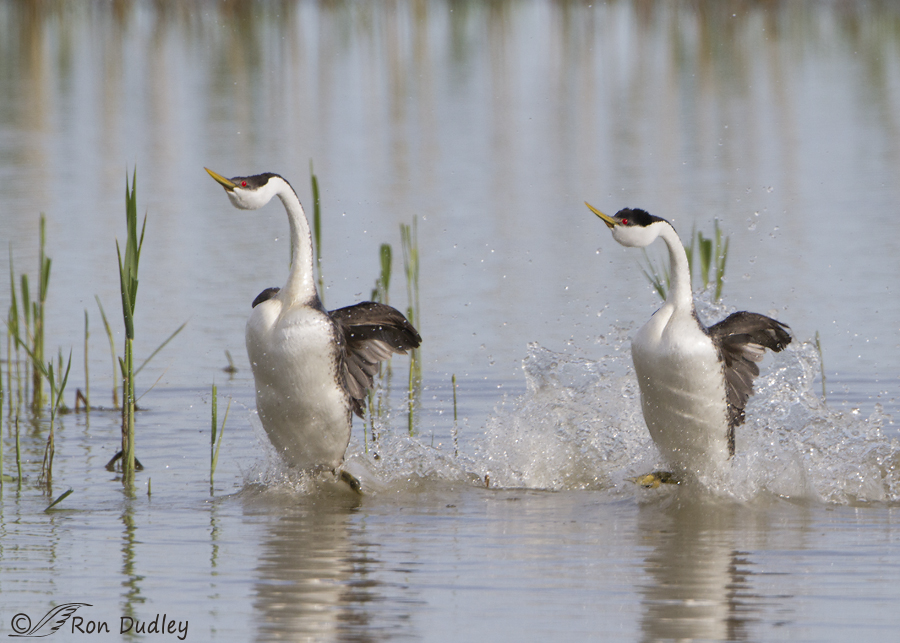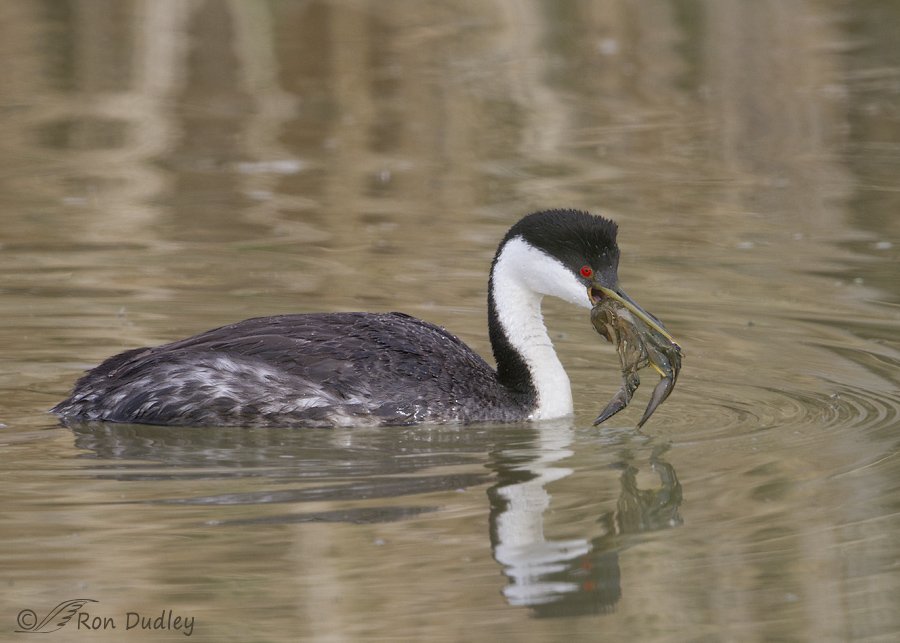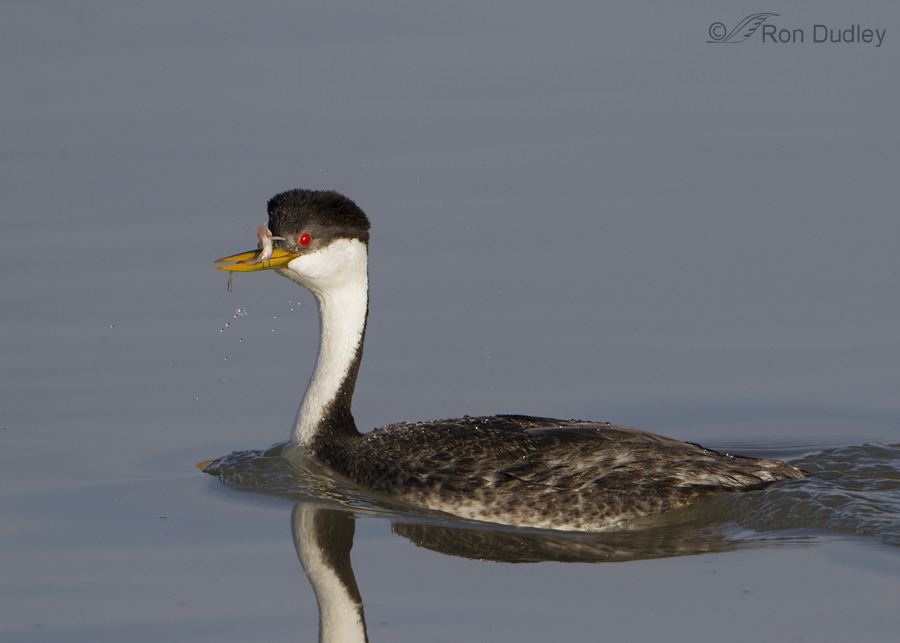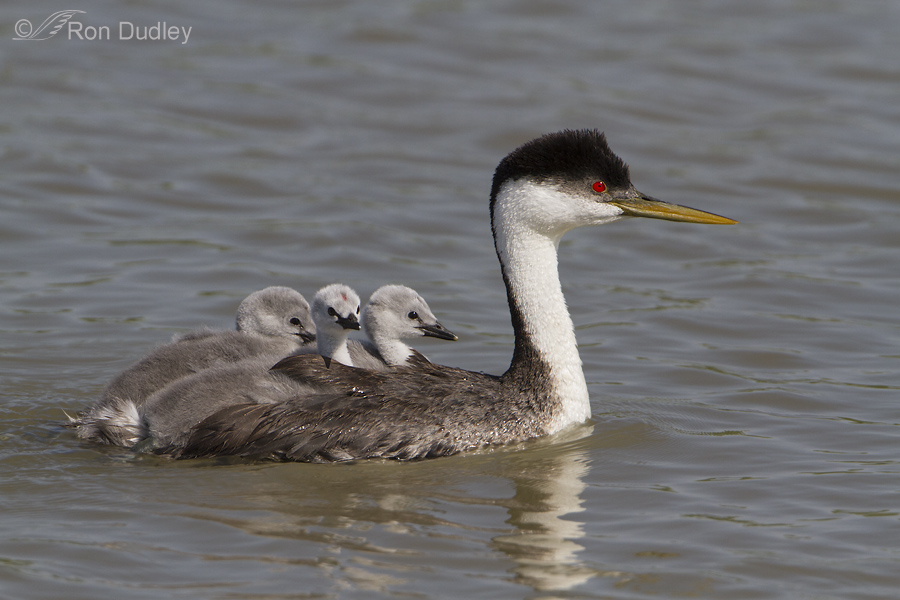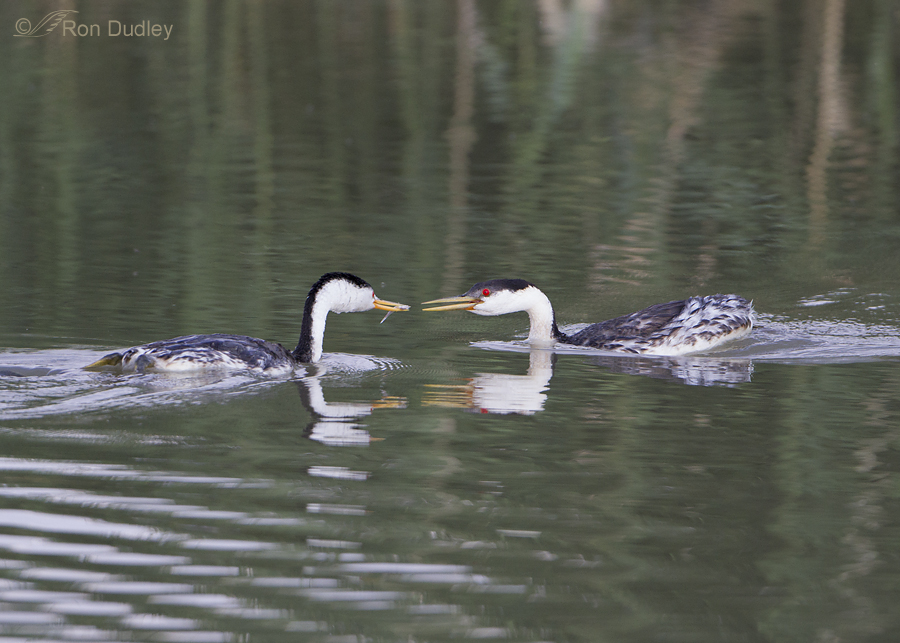Tag: western grebe
Western And Clark’s Grebes – A Comparison
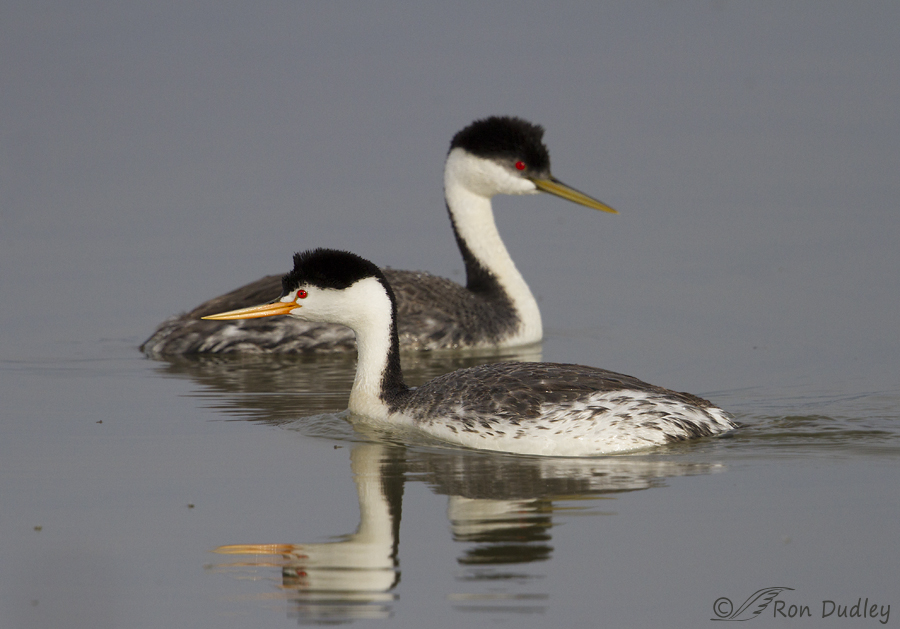
Western Grebes and Clark’s Grebes are so similar in plumage patterns and behaviors that until 1985 they were considered to be color phases of the same species – the Western Grebe. In fact they’re similar enough that many observers never even recognize Clark’s Grebes when they see them and assume that they’re the more common Western Grebe.
Western Grebe Swallowing A Crayfish
Western Grebe With Fish
Western Grebe Back-brooded Chicks (and what’s the function of that red crown patch?)
Western Grebe – Dumping The Chick Load
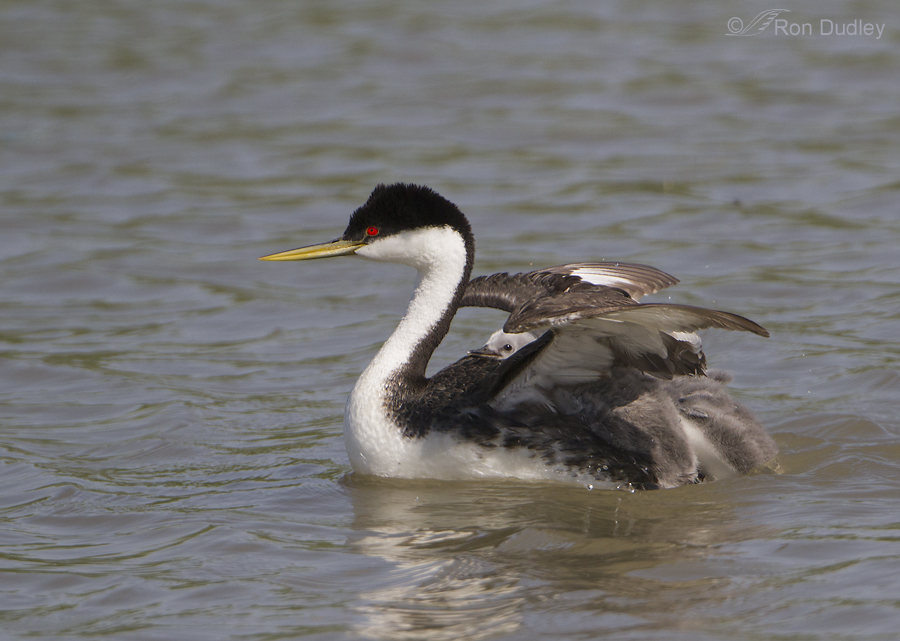
At this age Western Grebe chicks are heavy-bodied, small headed, loud, awkward and demanding. They alternately ride on the back of each parent (back brooding) as the other adult rests or hunts for fish to feed to its family. At this stage the youngsters are good swimmers and there’s often not enough room on the parents back for all of the chicks to ride comfortably anyway so the parent uses an interesting strategy to “dump its load” into the water when it needs a break.
Western Grebe Mated With Clark’s Grebe
Western Grebe Fish Delivery
Temperatures are finally warming a bit here in northern Utah but the world is outside is still monotonously white. Yesterday morning I measured 22 1/2″ of snow on the north end of Antelope Island, indicating that our bleak and largely featureless landscape will remain the same for the foreseeable future. So this morning I needed a break and decided to post an image (taken this past June at Bear River MBR) that would remind me that spring is somewhere out there on the distant horizon. 1/3200, f/7.1, ISO 640, 500 f/4, 1.4 tc, natural light Western Grebes are devoted parents to their incessantly hungry and noisy chicks. The male and female take turns with their parental duties – one will back brood the youngsters while the other delivers fish and then they alternate responsibilities. Here the female (smaller than the male, with a shorter, thinner bill – thus sexual dimorphism) has caught a small fish and is delivering it to the male. Usually the parent receiving the fish will give it to the chick, as happened here. As I’m sure is obvious, I’m very much looking forward to watching and photographing springtime bird activities once again. It’s going to be a very long 2-3 months… Ron
Clark’s Grebes – Parents Feeding Fish To Some Very Excited Chicks
This past June I spent lots of time with Western and Clark’s Grebes as they were raising their families. The two species are quite similar but the adult birds in this post can be recognized as Clark’s Grebes by their bright yellow-orange bills and the fact that their eyes are surrounded by white plumage, rather than black. 1/2000. f/7.1, ISO 500, 500 f/4, 1.4 tc, natural light This female of a mated pair was fishing for her family as the male back-brooded two chicks (the sexes take turns with each role). I happened to catch her just as she emerged from the water with a fish and shook the water off. I wish I had better eye contact and more room around the grebe, but this image is full frame. I include it here because it’s the logical beginning of this “fish story”. 1/2000. f/8, ISO 500, 500 f/4, 1.4 tc, natural light Seconds later she swam over to deliver the fish to her family. Sometimes the fish will be given to the brooding parent, who may eat it or give it to a chick. Other times, the fishing parent gives it directly to one of the youngsters. Either way, if the chicks are hungry they become very excited and aggressive in their attempts to be the one who gets the fish. Before the young birds saw breakfast coming their way, they were tucked down peacefully under each wing with only their heads and necks sticking out. All that changed in an instant. 1/2000….
Western Grebe Chick Reacts To Food
I’ve always enjoyed spending time with Western Grebes but until this past summer I’ve had very little success in photographing parents back-brooding their chicks. In June at Bear River Migratory Bird Refuge my luck with this behavior changed and I was able to get quite a few nice images of the chicks on the backs of the parents over many days. Here, two chicks wait patiently on the back of one of the parents while the other one attempts to catch fish for breakfast. The fishing parent would feed small fish to both chicks and to the brooding parent. The chicks watch attentively for the adult to emerge from the nearby water with something to eat. I was always torn about what to photograph – the parent with the fish or the reactions of the chicks to approaching food. In this case I chose the latter. Here, the chick on the right has just spotted its parent come up out of the water from behind with a small fish and is beginning to react. Usually, both chicks were hungry and competed for the food but this time the youngster on the left was full and not interested in anything to eat. But the chick on the right didn’t know that and went into full competetive begging mode. I always enjoyed watching these reactions to food. Ron
Western Grebes: A Bizarre Behavior Finally Explained
Anyone who has spent a significant amount of time observing Western Grebes (or their close relatives, Clark’s Grebes) has undoubtedly observed this curious behavior multiple times. But before I continue, a few words of explanation are in order. Grebes are unique to most other water birds in two ways that are related to this behavior: 1.) their legs are attached to their bodies at the rear, rather than underneath and 2.) the toes of grebes are lobed instead of webbed. Having legs attached at the rear allows for efficient swimming but causes extreme clumsiness while walking – they rarely venture on to land, but when they do they often fall down after just a few steps. This leg attachment position is so distinctive of grebes that the genus name of four of the North American grebe species is Podiceps (from “podicis” meaning anus or vent and “pes” meaning foot) – in other words, “anus foot”. (and yes, I’m having a hard time resisting a joke line or two with that phrase…) Recent experimental work with grebes has demonstrated that the lobes on the toes function much like the hydrofoil blades of a propeller. Ok, with that background, on to this strange behavioral quirk of the Western Grebe. Without warning, and for no apparent reason, they stick one of their legs out behind them. With those unusual feet it can look pretty silly. Sometimes they’ll do a simultaneous wing stretch, but rarely. Occasionally they’ll hold the foot high in the air for quite a while. That can look even sillier. Even the chicks do it….
Western Grebe Chick – A Lesson Learned In Feather Eating
Most grebe species are well known for feather-eating and the Western Grebe is certainly no exception. I’ve seen and photographed them gobbling down feathers multiple times. While the purpose of such behavior remains unproven it is suspected that the feathers enable more efficient digestion of fish bones and aid in removing digestive parasites. I’ve discussed this in further detail and provided more images of the behavior here. 1/2000, f/8, ISO 500, 500 f/4, 1.4 tc The feathers on their flanks and scapulars are in almost constant molt and when grooming dislodges them they are deliberately swallowed. Often, as was the case here, the feather is floating on the surface of the water and the grebe simply snatches it up as it floats by. 1/2000, f/8, ISO 500, 500 f/4, 1.4 tc But this time the feather was fed to the chick on the back of the parent. Adults begin feeding feathers to their offspring on the first day of their lives. BNA reports that researchers have found over 300 feathers in the stomachs of individual chicks that were no more than three days old. 1/1600, f/7.1, ISO 500, 500 f/4, 1.4 tc But of course not just any old feather will do. It must be small, soft and downy and without a stiff quill but apparently this is a lesson that the chicks must learn for themselves. As soon as the youngsters begin to make occasional forays off the backs of their parents and into open water they begin to experiment with feathers they…
Western Grebes – Aggressive Speed Demons
I’ve spent a lot of time over the years watching and photographing the behaviors of Western Grebes and I’ve been impressed by both their aggressive tendencies toward other birds and by their incredible acceleration and speed in “running” across the water at those same birds. In my experience that aggression is most often directed toward other grebes in defense of mates, chicks or feeding areas but they are also aggressive toward a variety of other species and are suspected of stabbing them with their bill from under water. BNA reports Mallards and Red-necked Grebes found dead from stab wounds to the abdomen that were probably administered by Western Grebes. I’ve found photographing them as they dash across the water to be very challenging because of their speed and the unpredictable nature of the behavior – it usually comes with little or no warning and direction is difficult to anticipate. 1/1250, f/6.3, ISO 640, 500 f/4 Though these birds appear slim while sitting on the water, in reality they are fairly chunky and at the end of one of these “runs” their wide body throws up quite a wide wake as they begin to slow down and settle back into the water – much like a speedboat after the engine has been cut. 1/1000, f/6.3, ISO 500, 500 f/4, 1.4 tc This grebe is early in the acceleration stage with its “bow” still raised high. 1/1000, f/6.3, ISO 500, 500 f/4, 1.4 tc And then another wake as it begins to settle into the water. 1/1600, f/6.3, ISO 500,…
Western Grebes Dumping Their Chicks
I haven’t posted for a few days because I’ve been in Montana for most of the past week. I have many images from that trip and hopefully some of them will appear here in the near future. But for now I’d like to report on another grebe behavior I photographed recently. This time it will be the Western Grebe, rather than the Clark’s Grebes in two of my recent posts. The two species are very similar and most easily distinguished by differences in bill color (Clark’s is bright yellow to orange-yellow while the Western’s bill is yellow to dull olive colored) and coloration around the eye (Clark’s is white surrounding the eye while the Western is dark around the eye). Both species rarely fly except during migration. In fact for much of the year they are incapable of flight because their flight muscles atrophy soon after arriving at their breeding grounds. So it’s my working theory that this might explain part of the reason why these grebes do so much wing flapping and stretching while sitting on the surface of the water – to excercise their relatively unused wings. Note: In many of these images I was too close to the birds to get an aesthetically pleasing composition so in most cases the birds will be too tight in the frame. But I think they show well the behavior I’m describing. 1/2000, f/10, ISO 500, 500 f/4, 1.4 tc This Western Grebe is in the middle of a wing-flap. They look so lithe and streamlined while…
“Rushing” Western Grebes
The ritualized displays and courtship ceremonies of Western Grebes are among the most complex known in the bird world. One of them is called the “rushing ceremony” which includes 5 distinct phases – only one of which is actually referred to as “rushing”. Yesterday I finally was able to photograph this most dramatic part of the display and believe me it’s been a long time coming. Mia and I were photographing a pair of these grebes with chicks and though we both were aware of another small group of grebes a little further away I was concentrating so intently on those chicks that I didn’t notice what Mia noticed – that the behavior of two of those birds had suddenly changed. She said “they’re going to do something” so all I had time to do was quickly aim my lens at these birds and fire away. Without Mia I’d have missed the entire sequence. 1/2500, f/7.1, ISO 500, 500 f/4, 1.4 tc When rushing, the two birds (usually a mated pair but two males may also do it to attract females) lunge forward and rise completely out of the water. 1/2500, f/7.1, ISO 500, 500 f/4, 1.4 tc As their legs and feet start to churn at incredible speeds their bodies begin to become more vertical… 1/2500, f/7.1, ISO 500, 500 f/4, 1.4 tc until the birds are almost completely vertical to the water and their feet are slapping the surface so fast (16-20 steps per second) that the slapping and splashing noise is loud and can be heard a great distance away. The…
Western And Clark’s Grebes – A Comparison

Western Grebes and Clark’s Grebes are so similar in plumage patterns and behaviors that until 1985 they were considered to be color phases of the same species – the Western Grebe. In fact they’re similar enough that many observers never even recognize Clark’s Grebes when they see them and assume that they’re the more common Western Grebe.
Western Grebe Swallowing A Crayfish
Western Grebe With Fish
Western Grebe Back-brooded Chicks (and what’s the function of that red crown patch?)
Western Grebe – Dumping The Chick Load

At this age Western Grebe chicks are heavy-bodied, small headed, loud, awkward and demanding. They alternately ride on the back of each parent (back brooding) as the other adult rests or hunts for fish to feed to its family. At this stage the youngsters are good swimmers and there’s often not enough room on the parents back for all of the chicks to ride comfortably anyway so the parent uses an interesting strategy to “dump its load” into the water when it needs a break.
Western Grebe Mated With Clark’s Grebe
Western Grebe Fish Delivery
Temperatures are finally warming a bit here in northern Utah but the world is outside is still monotonously white. Yesterday morning I measured 22 1/2″ of snow on the north end of Antelope Island, indicating that our bleak and largely featureless landscape will remain the same for the foreseeable future. So this morning I needed a break and decided to post an image (taken this past June at Bear River MBR) that would remind me that spring is somewhere out there on the distant horizon. 1/3200, f/7.1, ISO 640, 500 f/4, 1.4 tc, natural light Western Grebes are devoted parents to their incessantly hungry and noisy chicks. The male and female take turns with their parental duties – one will back brood the youngsters while the other delivers fish and then they alternate responsibilities. Here the female (smaller than the male, with a shorter, thinner bill – thus sexual dimorphism) has caught a small fish and is delivering it to the male. Usually the parent receiving the fish will give it to the chick, as happened here. As I’m sure is obvious, I’m very much looking forward to watching and photographing springtime bird activities once again. It’s going to be a very long 2-3 months… Ron
Clark’s Grebes – Parents Feeding Fish To Some Very Excited Chicks
This past June I spent lots of time with Western and Clark’s Grebes as they were raising their families. The two species are quite similar but the adult birds in this post can be recognized as Clark’s Grebes by their bright yellow-orange bills and the fact that their eyes are surrounded by white plumage, rather than black. 1/2000. f/7.1, ISO 500, 500 f/4, 1.4 tc, natural light This female of a mated pair was fishing for her family as the male back-brooded two chicks (the sexes take turns with each role). I happened to catch her just as she emerged from the water with a fish and shook the water off. I wish I had better eye contact and more room around the grebe, but this image is full frame. I include it here because it’s the logical beginning of this “fish story”. 1/2000. f/8, ISO 500, 500 f/4, 1.4 tc, natural light Seconds later she swam over to deliver the fish to her family. Sometimes the fish will be given to the brooding parent, who may eat it or give it to a chick. Other times, the fishing parent gives it directly to one of the youngsters. Either way, if the chicks are hungry they become very excited and aggressive in their attempts to be the one who gets the fish. Before the young birds saw breakfast coming their way, they were tucked down peacefully under each wing with only their heads and necks sticking out. All that changed in an instant. 1/2000….
Western Grebe Chick Reacts To Food
I’ve always enjoyed spending time with Western Grebes but until this past summer I’ve had very little success in photographing parents back-brooding their chicks. In June at Bear River Migratory Bird Refuge my luck with this behavior changed and I was able to get quite a few nice images of the chicks on the backs of the parents over many days. Here, two chicks wait patiently on the back of one of the parents while the other one attempts to catch fish for breakfast. The fishing parent would feed small fish to both chicks and to the brooding parent. The chicks watch attentively for the adult to emerge from the nearby water with something to eat. I was always torn about what to photograph – the parent with the fish or the reactions of the chicks to approaching food. In this case I chose the latter. Here, the chick on the right has just spotted its parent come up out of the water from behind with a small fish and is beginning to react. Usually, both chicks were hungry and competed for the food but this time the youngster on the left was full and not interested in anything to eat. But the chick on the right didn’t know that and went into full competetive begging mode. I always enjoyed watching these reactions to food. Ron
Western Grebes: A Bizarre Behavior Finally Explained
Anyone who has spent a significant amount of time observing Western Grebes (or their close relatives, Clark’s Grebes) has undoubtedly observed this curious behavior multiple times. But before I continue, a few words of explanation are in order. Grebes are unique to most other water birds in two ways that are related to this behavior: 1.) their legs are attached to their bodies at the rear, rather than underneath and 2.) the toes of grebes are lobed instead of webbed. Having legs attached at the rear allows for efficient swimming but causes extreme clumsiness while walking – they rarely venture on to land, but when they do they often fall down after just a few steps. This leg attachment position is so distinctive of grebes that the genus name of four of the North American grebe species is Podiceps (from “podicis” meaning anus or vent and “pes” meaning foot) – in other words, “anus foot”. (and yes, I’m having a hard time resisting a joke line or two with that phrase…) Recent experimental work with grebes has demonstrated that the lobes on the toes function much like the hydrofoil blades of a propeller. Ok, with that background, on to this strange behavioral quirk of the Western Grebe. Without warning, and for no apparent reason, they stick one of their legs out behind them. With those unusual feet it can look pretty silly. Sometimes they’ll do a simultaneous wing stretch, but rarely. Occasionally they’ll hold the foot high in the air for quite a while. That can look even sillier. Even the chicks do it….
Western Grebe Chick – A Lesson Learned In Feather Eating
Most grebe species are well known for feather-eating and the Western Grebe is certainly no exception. I’ve seen and photographed them gobbling down feathers multiple times. While the purpose of such behavior remains unproven it is suspected that the feathers enable more efficient digestion of fish bones and aid in removing digestive parasites. I’ve discussed this in further detail and provided more images of the behavior here. 1/2000, f/8, ISO 500, 500 f/4, 1.4 tc The feathers on their flanks and scapulars are in almost constant molt and when grooming dislodges them they are deliberately swallowed. Often, as was the case here, the feather is floating on the surface of the water and the grebe simply snatches it up as it floats by. 1/2000, f/8, ISO 500, 500 f/4, 1.4 tc But this time the feather was fed to the chick on the back of the parent. Adults begin feeding feathers to their offspring on the first day of their lives. BNA reports that researchers have found over 300 feathers in the stomachs of individual chicks that were no more than three days old. 1/1600, f/7.1, ISO 500, 500 f/4, 1.4 tc But of course not just any old feather will do. It must be small, soft and downy and without a stiff quill but apparently this is a lesson that the chicks must learn for themselves. As soon as the youngsters begin to make occasional forays off the backs of their parents and into open water they begin to experiment with feathers they…
Western Grebes – Aggressive Speed Demons
I’ve spent a lot of time over the years watching and photographing the behaviors of Western Grebes and I’ve been impressed by both their aggressive tendencies toward other birds and by their incredible acceleration and speed in “running” across the water at those same birds. In my experience that aggression is most often directed toward other grebes in defense of mates, chicks or feeding areas but they are also aggressive toward a variety of other species and are suspected of stabbing them with their bill from under water. BNA reports Mallards and Red-necked Grebes found dead from stab wounds to the abdomen that were probably administered by Western Grebes. I’ve found photographing them as they dash across the water to be very challenging because of their speed and the unpredictable nature of the behavior – it usually comes with little or no warning and direction is difficult to anticipate. 1/1250, f/6.3, ISO 640, 500 f/4 Though these birds appear slim while sitting on the water, in reality they are fairly chunky and at the end of one of these “runs” their wide body throws up quite a wide wake as they begin to slow down and settle back into the water – much like a speedboat after the engine has been cut. 1/1000, f/6.3, ISO 500, 500 f/4, 1.4 tc This grebe is early in the acceleration stage with its “bow” still raised high. 1/1000, f/6.3, ISO 500, 500 f/4, 1.4 tc And then another wake as it begins to settle into the water. 1/1600, f/6.3, ISO 500,…
Western Grebes Dumping Their Chicks
I haven’t posted for a few days because I’ve been in Montana for most of the past week. I have many images from that trip and hopefully some of them will appear here in the near future. But for now I’d like to report on another grebe behavior I photographed recently. This time it will be the Western Grebe, rather than the Clark’s Grebes in two of my recent posts. The two species are very similar and most easily distinguished by differences in bill color (Clark’s is bright yellow to orange-yellow while the Western’s bill is yellow to dull olive colored) and coloration around the eye (Clark’s is white surrounding the eye while the Western is dark around the eye). Both species rarely fly except during migration. In fact for much of the year they are incapable of flight because their flight muscles atrophy soon after arriving at their breeding grounds. So it’s my working theory that this might explain part of the reason why these grebes do so much wing flapping and stretching while sitting on the surface of the water – to excercise their relatively unused wings. Note: In many of these images I was too close to the birds to get an aesthetically pleasing composition so in most cases the birds will be too tight in the frame. But I think they show well the behavior I’m describing. 1/2000, f/10, ISO 500, 500 f/4, 1.4 tc This Western Grebe is in the middle of a wing-flap. They look so lithe and streamlined while…
“Rushing” Western Grebes
The ritualized displays and courtship ceremonies of Western Grebes are among the most complex known in the bird world. One of them is called the “rushing ceremony” which includes 5 distinct phases – only one of which is actually referred to as “rushing”. Yesterday I finally was able to photograph this most dramatic part of the display and believe me it’s been a long time coming. Mia and I were photographing a pair of these grebes with chicks and though we both were aware of another small group of grebes a little further away I was concentrating so intently on those chicks that I didn’t notice what Mia noticed – that the behavior of two of those birds had suddenly changed. She said “they’re going to do something” so all I had time to do was quickly aim my lens at these birds and fire away. Without Mia I’d have missed the entire sequence. 1/2500, f/7.1, ISO 500, 500 f/4, 1.4 tc When rushing, the two birds (usually a mated pair but two males may also do it to attract females) lunge forward and rise completely out of the water. 1/2500, f/7.1, ISO 500, 500 f/4, 1.4 tc As their legs and feet start to churn at incredible speeds their bodies begin to become more vertical… 1/2500, f/7.1, ISO 500, 500 f/4, 1.4 tc until the birds are almost completely vertical to the water and their feet are slapping the surface so fast (16-20 steps per second) that the slapping and splashing noise is loud and can be heard a great distance away. The…


